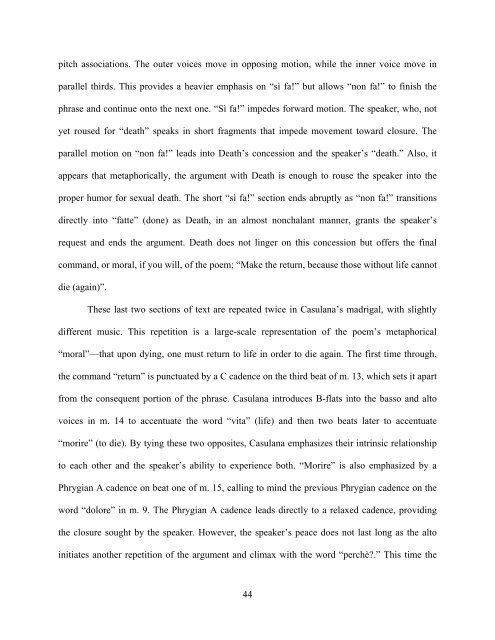Download - D-Scholarship@Pitt - University of Pittsburgh
Download - D-Scholarship@Pitt - University of Pittsburgh
Download - D-Scholarship@Pitt - University of Pittsburgh
You also want an ePaper? Increase the reach of your titles
YUMPU automatically turns print PDFs into web optimized ePapers that Google loves.
pitch associations. The outer voices move in opposing motion, while the inner voice move in<br />
parallel thirds. This provides a heavier emphasis on “sì fa!” but allows “non fa!” to finish the<br />
phrase and continue onto the next one. “Sì fa!” impedes forward motion. The speaker, who, not<br />
yet roused for “death” speaks in short fragments that impede movement toward closure. The<br />
parallel motion on “non fa!” leads into Death’s concession and the speaker’s “death.” Also, it<br />
appears that metaphorically, the argument with Death is enough to rouse the speaker into the<br />
proper humor for sexual death. The short “sì fa!” section ends abruptly as “non fa!” transitions<br />
directly into “fatte” (done) as Death, in an almost nonchalant manner, grants the speaker’s<br />
request and ends the argument. Death does not linger on this concession but <strong>of</strong>fers the final<br />
command, or moral, if you will, <strong>of</strong> the poem; “Make the return, because those without life cannot<br />
die (again)”.<br />
These last two sections <strong>of</strong> text are repeated twice in Casulana’s madrigal, with slightly<br />
different music. This repetition is a large-scale representation <strong>of</strong> the poem’s metaphorical<br />
“moral”—that upon dying, one must return to life in order to die again. The first time through,<br />
the command “return” is punctuated by a C cadence on the third beat <strong>of</strong> m. 13, which sets it apart<br />
from the consequent portion <strong>of</strong> the phrase. Casulana introduces B-flats into the basso and alto<br />
voices in m. 14 to accentuate the word “vita” (life) and then two beats later to accentuate<br />
“morire” (to die). By tying these two opposites, Casulana emphasizes their intrinsic relationship<br />
to each other and the speaker’s ability to experience both. “Morire” is also emphasized by a<br />
Phrygian A cadence on beat one <strong>of</strong> m. 15, calling to mind the previous Phrygian cadence on the<br />
word “dolore” in m. 9. The Phrygian A cadence leads directly to a relaxed cadence, providing<br />
the closure sought by the speaker. However, the speaker’s peace does not last long as the alto<br />
initiates another repetition <strong>of</strong> the argument and climax with the word “perchè?.” This time the<br />
44















